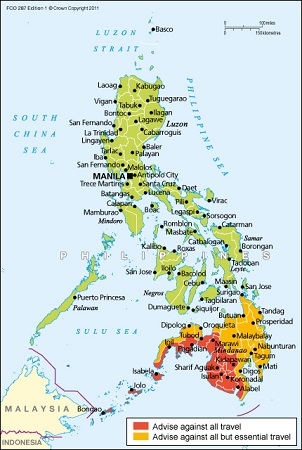PH is 80 percent safe for travel, UK embassy tells British tourists, nationals

British Embassy officials Thomas Phipps (right), Second Secretary and Stephen Lysaght (left), Head of Political Section explain to reporters that eighty percent of the country is considered safe for travel for British tourists despite UK’s travel advice discouraging all travels in the country. MATIKAS SANTOS
MANILA, Philippines—The Embassy of the United Kingdom (UK) said Tuesday that around 80 percent of the country is safe for British tourists and their no-travel advise covers only several provinces in Mindanao that are under conflict from armed groups.
The UK embassy’s current travel advisory posted on their website www.gov.uk urges British nationals “against all travel to south-west Mindanao and the Sulu archipelago because of on-going terrorist activity and clashes between the military and insurgent groups.”
Thomas Phipps, Second Secretary of the British Embassy in the Philippines told reporters in a briefing Tuesday that “[For] the rest of entire Philippines [such as] Visayas and Luzon, we have no warnings in going there at all.”
“Actually for around 80 percent of the country, we have no warnings in place. It’s absolutely fine to visit [those areas],” he said.

A travel advisory map of the UK Embassy shows the red areas that are under the advisory against all travel and those orange areas that are under the advisory against all but essential travel. The rest of the country are green which means no travel warnings. CONTRIBUTED PHOTO/Foreign Commonwealth Office of the UK government website.
Stephen Lysaght, Head of Political Section, said that they are actually encouraging British businesses and tourists to come to the Philippines and informing them of the risks in certain areas in the southern parts of the country.
“We are encouraging more British businesses to come and set up here, we are encouraging more British tourists to come here, we have a growing and thriving British community,” Lysaght said.
“The Philippines is a place we advise coming to, we think you will have a great time,” he said.
Historically, armed insurgent groups in the southern part of the country have caused violence in the Zamboanga peninsula and Sulu Archipelago. Kidnap-for-ransom groups have also targeted foreigners that were vacationing in the region.
The UK has three travel warning levels indicated on a map of the Philippines: Red for “advise against all travel”, orange for “advise against all but essential travel”, and green for “no travel warning.”
The UK has maintained their advise against all travel to the Mindanao region for many years with frequent updates about safety and security concerns as well as incidents of violence or accidents.
Lysaght said that the number of British nationals that they think are residents in the country has grown from 10,000 to 15,000 and that their arrivals suggest that there is a strong growth.
Phipps added that there are more British businesses and tourists in the country than any other country in Europe.
“As we see progress in the peace process should we revisit our travel advice for Mindanao? If a peace agreement is signed and if we are confident it is a lasting peace agreement … the first area that will change are the areas that are orange,” he said.
“The areas that are red, were going to have to give more consideration to … it’s often after a peace agreement is signed that you see a spike in violence because there are groups that will want to undermine the progress that’s being made,” Phipps said.
Both Lysaght and Phipps expressed their confidence in the peace in the country and the security forces as they both have first-hand experience in going to public places in many parts of the country.
The travel advisory in their website under the terrorism subsection however continues to state that “there is a high threat from terrorism throughout the country.”
“Terrorist groups continue to plan attacks and have the capacity and the intent to carry out attacks at anytime and anywhere in the country. Attacks could be indiscriminate, including in places frequented by foreigners like airports, shopping malls, public transport and places of worship,” it said.
The advisory also said that the visit of an estimated 113,282 British nationals in 2012 were trouble-free.